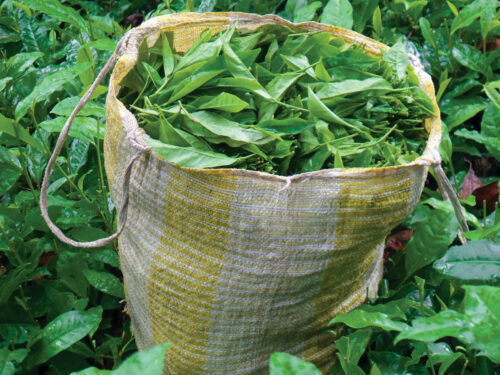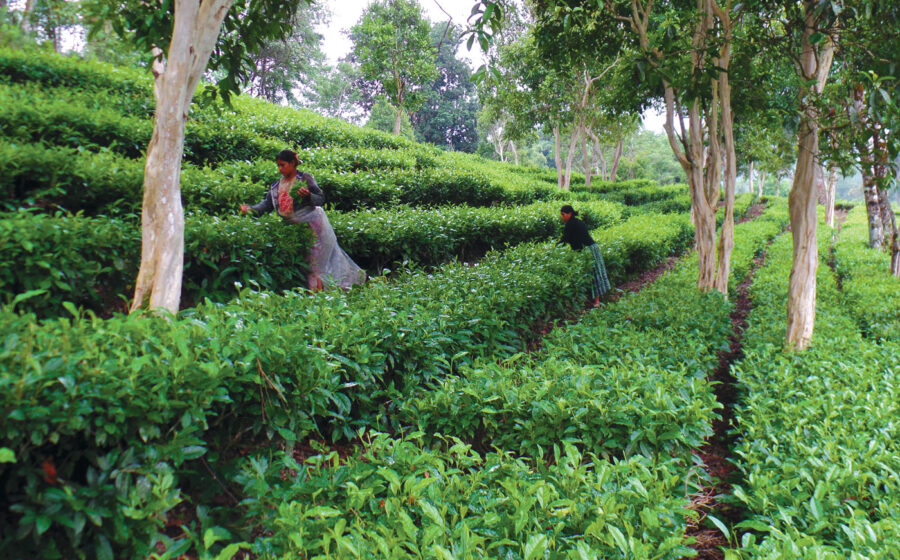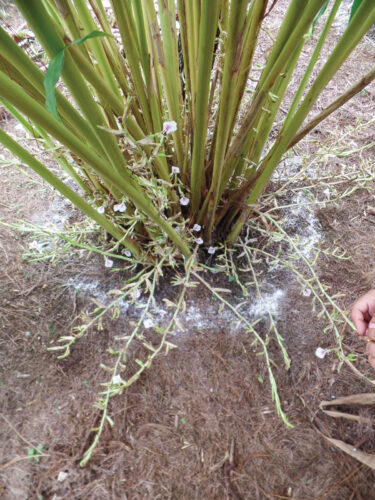[A] visit to Guatemala was long overdue. My company, SerendipiTea, has imported organic black tea from the country since 2011 and I had been seeking new sources for ingredients such as cardamom, clove, and allspice. Truth be known, my wanderlust was also kicking in, so plans were made for a May journey south for both business and pleasure. Guatemala’s rich culture, history, and environment have so much to offer travelers of all interests. For those of us in the tea and coffee business, it’s a virtual paradise, with coffee, tea, cacao, and various spices all grown there. Visiting fincas is an excellent way to enjoy a relaxing, inexpensive get away while being immersed in a hands-on experience that is certain to lead to personal as well as professional growth.
I flew into the small, bustling airport in polluted, congested Guatemala City. I left the city quickly and headed for Antigua. Within forty-five minutes a welcoming gem of boundless charm appeared. A volcanic triptych framing the old city provided sure-shot photo-ops with dramatic effects only Mother Nature could conjure. It was a relaxing jaunt in this 500-year-old city, visiting Spanish colonial ruins and taking in the vibrant sights and sounds of the local, Maya-influenced culture.
To reach the farms and gardens that cultivate the organic cardamom and tea I had come for, I headed north to a much harder city. These two products are not readily associated with Guatemala even though the country is the world’s leading producer and exporter of cardamom. The Chirrepec Cooperative’s organic tea garden dates to the late 1800s.
The only route from Antigua to Cobán, the capital of the Alta Verapaz Department, is a five-hour journey. Transportation options include chicken bus, tourist van, or hired car. It was my first visit and my Spanish is next to non-existent, so I opted for the hired car.
Where Antigua is comfortable with a storybook feel, Cobán is a gritty city of a quarter million and attracts few tourists. While a traveler can feel peace, calm, and safety in Guatemala, the country’s history has been wracked with violence. The twentieth century was replete with coups and juntas, ending with a nearly forty-year long civil war that killed more than 200,000 people, most by the government. The war gave way to organized crime and murder rates worse than almost anywhere. The indigenous Maya people suffered greatly throughout every wave of unrest. Vigilance and guarded caution is advised when traveling to Cobán. Only a few short years ago Mexican drug cartels pushed into this mountainous region and created many problems. The Guatemalan government sent the army to squelch the cartels and although the military remains, citizens say things are much better.
Not knowing the region, it would be difficult to find any of the many fincas spotting the mountainous areas (elevation approximately 4,000 feet) just outside the urban sprawl. Fortunately, I had arranged to meet Samy Lopez, production and business manager of Fedecovera, an organization founded in 1976 that works directly with many agricultural cooperatives in the Highlands and other growing regions in Guatemala.

Samy grew up in a tiny village about an hour north of Cobán. For young villagers continuing their education beyond secondary school, three options were available: accounting, teaching, and agriculture. Samy attended university to become an agricultural engineer. He landed a much coveted job with Fedecovera as an adviser to member farmers. To communicate with the farming communities he learned Q’eqchi’, one of the most common of the country’s twenty-one Maya languages. To expand the cooperatives’ reach, he was sent to an English-immersion program in Canada. Soon after, he earned a graduate degree in international business and marketing. The young boy who dreamed big now exudes confidence along with a sense of loyalty and responsibility to his country’s agricultural workers. With a deep-seated belief that farmers must be treated fairly and empowered, Samy, through his position at Fedecovera, provides tools and opportunities to ensure a productive future for cooperative members.
Most of the small farms that form the cooperatives are owned and operated by various Maya groups; in Cobán the population is largely Q’eqchi’. One could say that agriculture is in their blood. In pre-Columbian times, Maya appeased their gods with comingled offerings of chocolate and blood. The Q’eqchi’ continued to shed blood over the last several centuries, no longer of their own accord but due to a seemingly continuous onslaught of external and internal oppressors. The passion for and commitment to the indigenous people shared by Samy and his colleagues are infectious.
Fedecovera’s mission is to work in alliance with the Maya farmers to ensure their livelihoods. The organization provides myriad services including health care, legal advice and representation if necessary, micro-loans, farming guidance, and business counsel. Fedecovera also purchases from the cooperatives at fair prices and builds relationships with customers locally and abroad. Even with all this support, the cooperative farmers under the Fedecovera umbrella are free to sell to whomever they wish—there are no obligations to work solely with Fedecovera. If a better offer is received from a broker or middleman, the choice is for the farming members to make.
Samy, who wears his dark hair short and has the fit build of farmers who work on their feet, was a walking font of information and I couldn’t have been more grateful for his flawless English. He explained that the cooperatives are modeled after Israeli kibbutzim and the moshavim. In a kibbutz, all members and families share the land and chores equally, sometimes the living and dining quarters are communal. In a moshav, land is owned by families but purchases, labor, and sales are pooled for greater returns. That unlikely connection is yet another reminder of the civil war. Throughout Guatemala’s tumultuous history, the less-fortunate living in rural areas bore the brunt of the brutalities. In the early 1980s, at the height of the civil war, which was mainly a guerrilla fight, Guatemalan air force Colonel Eduardo Wohlers developed a counterinsurgency plan to provide assistance to farming families to assuage frustration and to curry favor with that population in an attempt to reduce the numbers participating in guerilla movements. Colonel Wohlers had visited Israel, which supplied military equipment and training to Guatemala, and while there he and dozens of other Guatemalan military leaders learned about kibbutz structures, especially in agriculture. He established Guatemala’s first kibbutz-style agricultural cooperative here in Alta Verapaz. It was fully operational in 1984 and its success led to the creation of more like it.
If the cooperatives have an unlikely model, they also produce unlikely crops. When discussing the cultivation of tea, cardamom, cloves, and allspice (items not typically consumed by locals), Samy explained that
Germans living in Guatemala at the turn of the nineteenth century noticed that Cobán was similar to areas in India. Quickly, they began successfully cultivating foreign crops.
The most striking is the Chirrepec Cooperative’s tea garden. Samy took me to the garden by jeep. Once there, I met the president and several acting officers of Chirrepec Cooperative (one of the founding members of Fedecovera) and I presented them a selection of my company’s retail boxes. Seeing their excitement as they held their tea packaged for US consumers was pure joy. A tour of the factory revealed Taiwanese-made machines, all those typically found in a black tea manufacturing operation. Historically, Té Chirrepeco, the cooperative’s tea brand, has produced varying grades of black tea exclusively. I learned that in recent years the Fedecovera advisor assigned to Té Chirrepeco spent much time in Taiwan expanding his tea knowledge, which he shares with the member farmers. Although it would take a significant capital investment in additional machinery, I expressed hope that we would soon be treated to green tea and perhaps even oolong-style options.
The ninety-two acres of this cooperative are vast and varied. More than 350 members live on them. The cooperative could be defined as biodiversity in a jungle environment or agro-forestry. Some tea lots are laid out in traditional terraced rows, where tea bushes are in full sun. In other sections tea plants are swallowed up in dense jungle flora. In Asian tea gardens, specialty tea leaves are plucked almost only by women. At Chirrepec, however, it was not uncommon to see men working the rows. All is well tended and there is moderate though bustling activity throughout the day along the smoothly paved road that winds from the factory through the gardens into the member farmers’ village. Pluckers pass in waves with full bags of leaves, the women balancing them atop their heads, the men slinging them like backpacks.
Pine for reforestation and edible vegetation are also grown on the grounds. And this enterprising group of farmers, with the assistance of Fedecovera, has diversified its business ventures by adding a small retail shop and a café near the garden entrance to capitalize on Guatemalan and foreign visitors to the mountain region who can take tours of the plantation. The cooperative even hopped on the RTD train and is bottling a sweetened iced tea!
A cardamom plant. Aside from visiting numerous farms with Samy in the mountains surrounding Cobán, I was treated to two very meaningful events. One was meeting Leonardo Delgado, general manager of Fedecovera. The other was being invited by Delgado to an important village meeting held for the closing of the harvest season at the Chilte Cooperative.
The modest, gated headquarters of Fedecovera are located on a Cobán side street where an armed guard permits passage to a private road occupied by a few buildings which include the warehouse and processing facility, offices, and a clinic. Along the short stretch of road, several more armed guards stood around casually but alert. From headquarters, señors Delgado and Lopez and I hopped into a rugged jeep and were off to a cardamom farm and the meeting.
On the outskirts of the city we turned onto a well-packed narrow dirt road. The climb to higher ground, familiar for anyone traveling to tea-country, began; but in comparison to the many treacherous mountain roads I’ve traveled in tea-growing regions in Asian countries, this was a joyful ride. Not one white-knuckle, Hail-Mary stretch did I experience. During the drive, Samy and Delgado pointed out numerous co-op farms under the Fedecovera umbrella.

Before arriving at the cardamom farm, which also grows coffee, allspice, and pine for reforestation programs, we stopped at several member farms where I received an education in discerning clove and allspice trees. The farms in these mountains are not neatly organized rows of crops but are integrated in a naturalistic way. Along the path to the cardamom-growing plot, there are seemingly random clusters of coffee plants and allspice trees as well as vegetables for the farmers’ tables. Farmers’ houses dot the growing areas, unlike tea and spice gardens in India or Sri Lanka where workers live in small villages, sometimes on the garden grounds. Chickens and turkeys roamed freely, but unlike other tea regions there are no animals like cows, mules, or pigs. There is, however, plenty of corn everywhere.
The village meeting hall, a simple, rectangular cinder block structure, is at the center of a clearing close to the road. Approximately 5,000 square-feet in size, the building is painted a deep, bold blue that makes it unmistakable from the road. It has a high ceiling and wide-open dirt floor covered with young pine branches that snapped out a pleasant scent as the crowd walked over them. A large flat-screen television hangs on the main interior wall above an elevated platform; rows of folding chairs fill the vast room when needed. A few small homes surround the immediate area, but because most of the member families’ homes are scattered a distance from each other, this hall serves many community purposes.
At the meeting, women and children dressed in their colorful best; men wore solemn expressions and were intent on absorbing the presentations. I was seated prominently and treated as a guest of honor. From a raised dais where the co-op counsel was assembled, Delgado introduced me ceremoniously. Loud, humbling applause ensued. After several hours of various Power Point presentations displayed in Spanish and Q’eqchi’ (the majority of the farming families do not speak Spanish), we were invited to a modest communal dining area in a nearby building that also houses the main office, where the co-op’s elected leaders and boards hold regular meetings. The local specialty of kakik (spicy turkey stew) and tortillas were served to the guests of honor: men and one woman from Fedecovera, me, and a few co-op leaders.
This short visit gave me a glimpse of the lives of farmers who provide the incredible ingredients that I blend with my teas. For them, I believe, it was worthwhile to connect their hard work to the person who is the penultimate link to the end of their supply chain.
—Linda Villano is the owner of SerendipiTea.




















